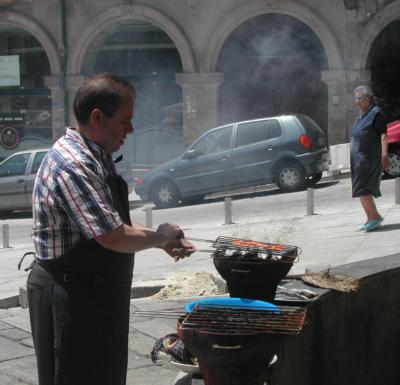Portugal’s delicacy
When the Portuguese talk about sardines, they generally don't mean those tiny skinned and boned creatures compressed into a minute can. They are referring to fresh, succulent sardines, the bigger, the fatter - the better. In Portugal, more than 60 percent of the national sardine catch is consumed fresh.
With about 500 miles of Atlantic coast, Portuguese fishermen can find more than 200 different kinds of fish in the coastal shoals, from cold-water bass and grouper to huge tuna en-route to spawning grounds in the Mediterranean. But the traineiras - small trawlers with wooden hulls and diesel engines - bring back smaller catch, such as grey bream, mackerel, octopuses and congers, and above all, sardines, which count for 40 percent of Portugal's fresh fish production, or about 100,000 tons a year.
Portugal's main fishing port is Peniche, Rally Portugal's 4th stopover - a rocky promontory jutting into the Atlantic that used to be located at the base of an ancient fortress that once served as a political prison and is now a museum. You can tell you are in sardine country as soon as you approach Peniche bay - the pungent odour of grilled sardines rises like a cloud of incense over the Avenida do Mar, where small charcoal grills have been set up in front of every restaurant.
 Sardines are a summertime pleasure to be enjoyed out of doors, like a barbecue. In reality, sardine season - when the fish are plump and juicy - lasts from the end of May to the end of October, although the fat fish can keep coming until December. The sardines are fleshy and almost sweet and are traditionally accompanied with boiled potatoes and a salad of grilled green pepper and tomato. They are served complete with head and tail and perhaps the best way to tackle the grilled fish is to nick the head and the tail, without cutting these off, then split the sardine down the front and detach the backbone, head and tail all in one piece, leaving only the savoury flesh. Some people like to remove the skin as well, particularly any scales, but the musky charcoal flavor of the skin is not to be missed. There's also a school of sardine-lovers who would rather just hold the head and tail in their hands and munch at the fish as they would corn on the cob.
Sardines are a summertime pleasure to be enjoyed out of doors, like a barbecue. In reality, sardine season - when the fish are plump and juicy - lasts from the end of May to the end of October, although the fat fish can keep coming until December. The sardines are fleshy and almost sweet and are traditionally accompanied with boiled potatoes and a salad of grilled green pepper and tomato. They are served complete with head and tail and perhaps the best way to tackle the grilled fish is to nick the head and the tail, without cutting these off, then split the sardine down the front and detach the backbone, head and tail all in one piece, leaving only the savoury flesh. Some people like to remove the skin as well, particularly any scales, but the musky charcoal flavor of the skin is not to be missed. There's also a school of sardine-lovers who would rather just hold the head and tail in their hands and munch at the fish as they would corn on the cob.
Sardines are sufficiently robust to stand up to hearty red table wines, and are rarely seen in any other company, except perhaps a fruity, effervescent red vinho verde, or new wine.